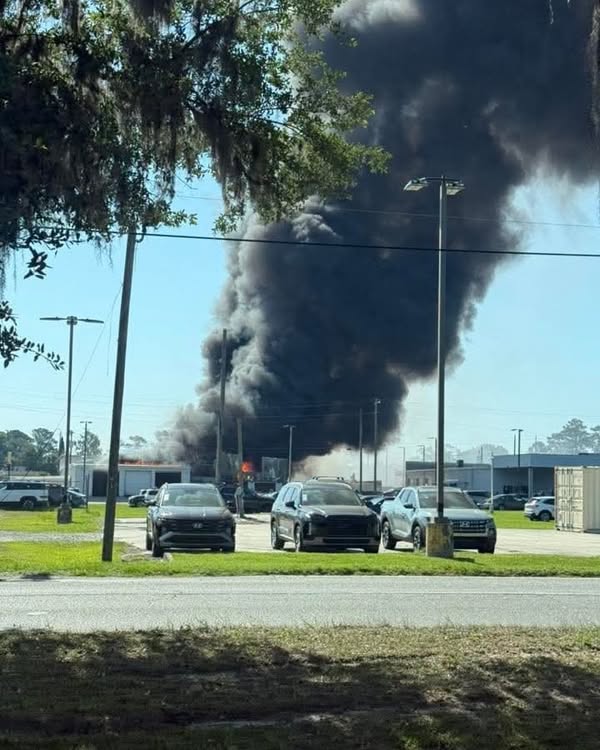In the quiet of a typical Savannah morning, with the sun rising steadily over Abercorn Street and early commuters beginning their daily routines, a sudden explosion shattered the calm, setting off a cascade of emergency response efforts that would grip the city’s attention for hours. On Friday, May 23, 2025, at approximately 9:49 a.m., a massive fire erupted at the AutoNation Volkswagen dealership located in the 7000 block of Abercorn Street, at the prominent intersection with Eisenhower Drive. This incident marked one of the most significant emergency responses in recent memory for the Savannah Fire Department and highlighted both the unpredictability of urban hazards and the resilience of local first responders.
First Signs of Disaster
The first indication of trouble came in the form of multiple 911 calls flooding dispatch centers with reports of a loud explosion, followed immediately by sightings of thick black smoke rising rapidly into the sky. Witnesses described the explosion as abrupt and forceful, capable of being heard from blocks away. Several callers mentioned feeling the rumble beneath their feet and seeing glass shake in nearby buildings, an indication of the blast’s force. Initial emergency alerts flagged a potential structural collapse in addition to the fire itself, a particularly dangerous combination for any urban response.
As these initial reports reached the Savannah Fire Department, multiple units were dispatched without hesitation. Given the dealership’s location—at a busy intersection known for both heavy commercial activity and nearby residential neighborhoods—the potential risk to human life and surrounding property was substantial. Fire engines, ladder trucks, rescue units, and support vehicles began converging on the scene, joined quickly by local law enforcement to manage traffic and establish safety perimeters.
Scene of Chaos and Urgency
When the first crews arrived, they were confronted with a scene of dramatic and urgent danger. Flames had already engulfed large sections of the dealership, including what appeared to be the showroom and possibly portions of the service area. The fire was described by officials as “aggressive,” with flames leaping high into the air and thick, acrid smoke billowing upward, visible for miles around. Traffic along Abercorn Street came to a halt, both due to emergency blockades and the gawking of stunned onlookers who had gathered nearby despite the obvious danger.
Within minutes, the decision was made to initiate a defensive strategy, the hallmark approach for fires deemed too dangerous for internal firefighting operations. In such situations, rather than sending personnel inside a burning structure, crews work from the exterior using aerial ladders, water cannons, and ground hoses to try to contain the fire’s spread and suppress flames as effectively as possible without compromising firefighter safety.
It was a decision grounded in both tactical necessity and concern for the unknowns still unfolding inside the dealership. Early speculation by fire officials included the possibility of hazardous materials inside the facility—such as flammable automotive fluids, compressed gas cylinders, or even lithium-ion batteries from electric vehicles. The nature of car dealerships, especially service departments, means that a wide variety of potentially explosive or toxic materials could be present, escalating both the complexity and risk of fire suppression efforts.
Community Response and Impact
As word of the fire spread across the city through social media and local news alerts, the surrounding community began reacting with alarm and concern. The AutoNation Volkswagen dealership is a well-known commercial fixture in the area, both for its large customer base and its prominent location. Numerous residents, many of whom had done business there, expressed shock at the scale of the fire and concern for employees who may have been on-site at the time of the explosion.
Fortunately, by mid-morning, officials confirmed that no injuries had been reported. This relief was met with cautious optimism, as investigators continued to scour the scene and confirm that all staff and any potential visitors had been accounted for. Evacuations of nearby businesses were conducted as a precaution, and traffic was rerouted away from the danger zone. Abercorn Street, a major arterial road in Savannah, was closed in both directions between Stephenson Avenue and Eisenhower Drive, creating significant traffic delays but ensuring that emergency responders could operate without obstruction.
Authorities quickly urged the public to avoid the area entirely and to use alternate routes. The police and fire departments jointly emphasized that crowding near the site, while understandable given the spectacle, posed serious safety risks and interfered with the flow of emergency operations. Despite these warnings, some residents continued to gather at a distance, recording videos and sharing updates online, a modern-day phenomenon that now often accompanies large-scale public emergencies.
Containment and Continued Risk
By 11:00 a.m., officials were able to confirm a significant turning point in the battle against the fire: the blaze had been contained. This did not mean that the fire was fully extinguished—hot spots, smoldering debris, and residual flames remained active throughout the structure—but it did mean that the fire was no longer actively spreading, and the threat to neighboring buildings had been mitigated.
Firefighters continued to work diligently, rotating personnel to ensure safety from heat exhaustion and smoke inhalation. Water was poured into the site from elevated platforms and ground hoses, focusing on areas where flare-ups were most likely to occur. The intense heat warped metal beams and melted vehicle frames, creating a surreal, skeletal wreckage that made clear the intensity of the morning’s inferno.
Meanwhile, arson investigators arrived on scene and began the methodical, painstaking task of determining how the fire began. At the time of this update, the cause remains undetermined, but officials emphasized that every avenue would be explored. This includes reviewing security footage from both the dealership and surrounding businesses, interviewing witnesses and employees, and inspecting electrical systems, gas lines, and potential ignition sources.
Given the early reports of a possible explosion, there is significant interest in understanding whether a mechanical failure, gas leak, electrical malfunction, or potentially even criminal intent played a role in the fire’s outbreak. Investigators are particularly focused on narrowing down the origin point—where the first flames were observed—as this can often offer the best clues toward establishing the fire’s cause.
Broader Implications and Reflections
Though no lives were lost and no injuries were reported, the fire’s impact extends far beyond the smoldering remains of the AutoNation dealership. For employees, the fire represents an immediate disruption to their livelihoods, with their place of work reduced to a charred ruin. For the dealership’s customers, questions arise about their vehicles—some of which may have been on the premises for servicing or repair at the time of the incident. For nearby business owners, the disruption to daily operations, traffic, and logistics adds a layer of stress and uncertainty.
On a larger scale, the fire contributes to growing concerns about fire safety preparedness in commercial zones. While car dealerships are not commonly associated with major fires, the combination of flammable materials, high-voltage components in modern electric vehicles, and expansive electrical systems does present a unique fire risk profile. The Savannah Fire Department, through this incident, has demonstrated both its readiness and its need for continued investment in training, equipment, and inter-agency coordination.
The fire also serves as a stark reminder of the unpredictability of urban life. In a matter of minutes, a normal business morning was transformed into a scene of emergency. Such moments underscore the importance of emergency preparedness—not just for first responders, but for the businesses, employees, and everyday citizens who may one day find themselves suddenly in the path of disaster.
Looking Ahead: Recovery and Investigation
As fire crews remain on scene, working to fully extinguish remaining hotspots and secure the area, the longer process of investigation and recovery is just beginning. The AutoNation corporation, one of the largest automotive retailers in the United States, will likely issue statements in the coming days regarding the damage, customer service continuity, and plans for rebuilding or relocating operations in Savannah.
In the interim, city officials will work with affected businesses and residents to address the immediate aftermath. Insurance assessments, structural inspections, environmental safety evaluations, and traffic restoration will all play a part in returning the area to normalcy. For many, the images of fire and destruction will linger long after the final flames are extinguished.
The Savannah Fire Department, along with state and possibly federal investigative partners, will continue to pursue answers to the fire’s origin. Whether the result of an accident, a systems failure, or something more malicious, the public’s desire for clarity is strong. For now, the cause remains unknown, but the assurance has been given that every effort is being made to find it.
Conclusion: A City Tested, A Response Commended
The fire at the AutoNation Volkswagen dealership will be remembered not just for the scale of its flames, but for the swift and effective response of Savannah’s emergency services. Within minutes of the explosion, a full-scale mobilization was underway, and thanks to the professionalism and dedication of first responders, a potentially catastrophic situation was contained without loss of life.
While the damage is extensive and the emotional toll considerable, the city’s resilience shines through. From emergency workers and investigators to local leaders and everyday residents, Savannah has once again shown that in moments of crisis, it stands united, responsive, and determined to recover.
As investigations continue and recovery begins, the lessons of this day—about preparation, coordination, and community—will not be soon forgotten. And as the smoke clears from Abercorn Street, the city turns, as it always does, toward the hard but hopeful path of rebuilding.


Leave a Reply